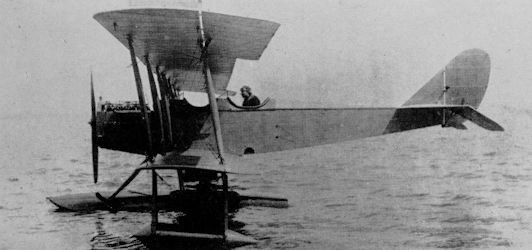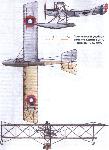
Описание
Страна: США
Год: 1917
Trainer seaplane
Варианты
- Curtiss - J / JN - 1914 - США
- Curtiss - N / O - 1914 - США
- Curtiss - JN-4 Jenny - 1916 - США
- Curtiss - JN-5 / JN Twin - 1916 - США
- Curtiss - N-9 / N-10 - 1917 - США
- Hewitt-Sperry - Automatic Airplane - 1917 - США
- P.Bowers Curtiss Aircraft 1907-1947 (Putnam)
- G.Swanborough, P.Bowers United States Military Aircraft Since 1909 (Putnam)
- G.Swanborough, P.Bowers United States Navy Aircraft Since 1911 (Putnam)
-
А.Шепс - Самолеты Первой мировой войны. Страны Антанты
Поплавковый учебный самолет Кертисс JN-9 "Дженни" U.S. Navy
-
G.Swanborough, P.Bowers - United States Military Aircraft since 1909 /Putnam/
Curtiss N-9 in early form
-
P.Bowers - Curtiss Aircraft 1907-1947 /Putnam/
The Curtiss N-9 was the standard US Navy primary trainer of World War I and early 1920s. Early models with Curtiss engines were retroactively identified as N-9C to distinguish them from later N-9H models with Hispano-Suiza engines.
-
Jane's All The World Aircraft 1919 /Jane's/
A Curtiss N-9 Type Training Seaplane, used by the US Navy from 1917 and also in limited number by the Army. 150 h.p. Hispano-Suiza A engine.
-
G.Swanborough, P.Bowers - United States Navy Aircraft since 1911 /Putnam/
The insignia change of January 1918, resulted in some interesting mixtures when stored components carrying old markings were installed on newer aeroplanes. Number 2363 at left has correct markings; 2382 has the order of tail stripe colours reversed, as in 1917, and the grey-painted aircraft extreme right has the 1917 star insignia on the wings but 1918 tail stripes.
-
G.Swanborough, P.Bowers - United States Navy Aircraft since 1911 /Putnam/
An N-9H with 150 hp American-built (as the Wright Model A) Hispano·Suiza engine and unique tower radiator. Burgess built N-9s under licence and the US Navy assembled many others from spare parts.
-
P.Bowers - Curtiss Aircraft 1907-1947 /Putnam/
Two N-10s were standard N-9 airframes fined with shorter-span wings for livelier performance as gunnery trainers.
-
C.Owers - The Fighting America Flying Boats of WWI Vol.2 /Centennial Perspective/ (23)
H-16 Bu No. A-4061 with a Curtiss N-9 trainer overhead.
Другие самолёты на фотографии: Curtiss H.16 Large America / F-5-L - США - 1917
-
C.Owers - The Fighting America Flying Boats of WWI Vol.2 /Centennial Perspective/ (23)
Curtiss H-16 boats A-836 and A-3479 on the hardstand.The Bureau Nos. marked on the hull sides indicates that these are US based H-16 boats, this photograph being taken at Pensacola Naval Air Station. Note how the last two numerals of the Bureau Nos. are painted on the bow. There appears to be two Curtiss HS-2L boats in the background but it is only one machine caught by the time exposure so that the Bureau No. A-2082 appears to be on the front and rear hull. This machine bears the "hat in the ring" insignia of one of the squadrons that operated from Pensacola. N-9 training biplanes are further to the rear.
Другие самолёты на фотографии: Curtiss H.16 Large America / F-5-L - США - 1917Curtiss HS - США - 1917
-
Журнал - Flight за 1918 г.
American aeroplane types of 1917-18: Curtiss "N9" Hydro.
P.Bowers Curtiss Aircraft 1907-1947 (Putnam)
N-9 (Model 5) - The N-9 of late 1916 was essentially a JN-4B fitted with the 100 hp Curtiss OXX engine, a single float, a lengthened centre section, and 5 ft (1,52 m) lower wing extensions on each side of the fuselage in the manner of the prototype N-8 in order to carry the additional weight of the floats. The control system was the Deperdussin type with the control wheel operating the ailerons and a foot-bar controlling the rudder. The prototype used JN-4B vertical tail surfaces and oversized ailerons; the vertical fin was enlarged on production models.
The US Army made limited use of the N-9, ordering fourteen early in 1917; the Navy was the principal user, ordering a total of 560 as primary trainers. Of these, only 100 were built by Curtiss; the rest were from Curtiss's wholly-owned subsidiary, the Burgess Co of Marblehead, Mass. Fifty additional airframes were built up at Navy bases from spare parts in the early 1920s; N-9s remained in US Navy service into 1927.
N-9C - Two designations were applied to the Navy N-9s. N-9C was not official but came into use after the later N-9H appeared in order to distinguish the original Curtiss-powered N-9s from the later versions. The principal identification point of the -9C was the exposed cylinder banks of the distinctive Curtiss OXX engine and the use of a nose radiator enlarged slightly over that of the JNs and the N-8 by having a curved area added at the bottom.
US Navy serial numbers: (Curtiss) A60/65 (6), A85/90 (6), A201 /234 (34), A294/301 (8), A342/373 (32), A2285. (Burgess) A409/438 (30), A999/1028 (30), A2351/2409 (59).
US Army serial numbers: 433/446 (14).
N-9C
Trainer seaplane. Two pilots. 100 hp Curtiss OXX.
Span 53 ft 4 in (16,25 m); length 29 ft 10 in (9,09 m); height 10 ft 10 1/2 in (3,31 m); wing area 496 sq ft (46,07 sq m).
Empty weight 1,860 lb (844 kg); gross weight 2,410 lb (1,093 kg).
Maximum speed 70 mph (112,65 km/h); climb in 10 min - 2,000 ft (610 m); range 200 miles (322 km).
N-9H - The N-9H designation was official, the letter identifying the 150 hp Wright-Hispano engine (Also known as the Wright A and the 'Hisso'). This installation differed considerably from the N-9C. The cylinder banks were exposed as on the N-9C but were different in appearance. The use of a large spinner over the propeller hub precluded the use of a nose radiator, so the cooling was done by a large column-like radiator that projected well above the wing. The Navy tested some N-9Hs with the 150 hp Curtiss K-6 engine but did not adopt the new powerplant. Cost was $10,050 less GFE.
US Navy serial numbers: (Curtiss) A2286/2290 (5). (Burgess) A2410/2572 (163), A2574/2650 (77). (NAS Pensacola postwar assembly) A6528/6542 (15), A6618/6633 (16), A6733/6742 (10), A7091/7100 (10).
N-9H
Trainer seaplane. Two pilots. 150 hp Wright A.
Span 53 ft 4 in (16,25 m); length 30 ft 10 in (9,39 m); height 10 ft 11 in (3,32 m); wing area 496 sq ft (46,07 sq m).
Empty weight 2,140 lb (971 kg); gross weight 2,750 lb (1,247 kg).
Maximum speed 78 mph (125,52 km/h); climb in 10 min - 3,240 ft (987 m); service ceiling 6,600 ft (2,012 m).
N-10 - The N-10 was not a new design in the Curtiss N-series. The two known examples were one Curtiss N-9C (A365) and one Burgess N-9H (A2473) fitted with shortened equal-span two-bay wings to produce a faster aeroplane for other than primary training duty. The Curtiss model was later refitted with the Wright-Hispano engine.
Описание:











